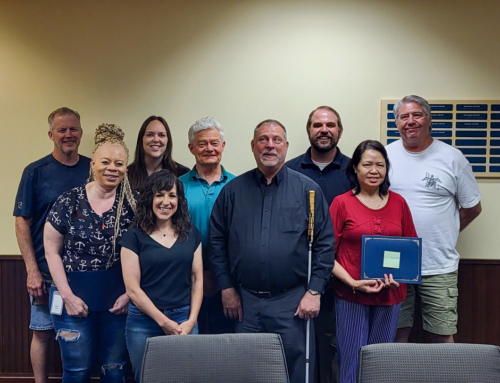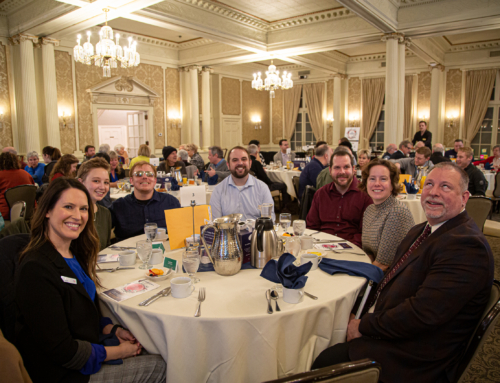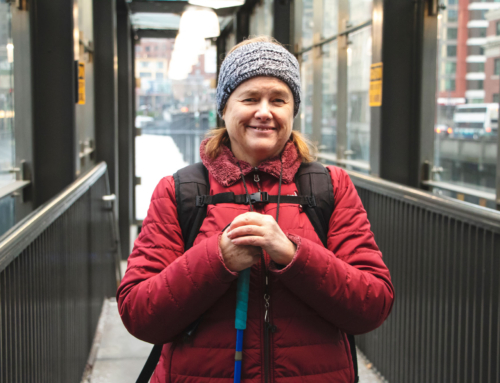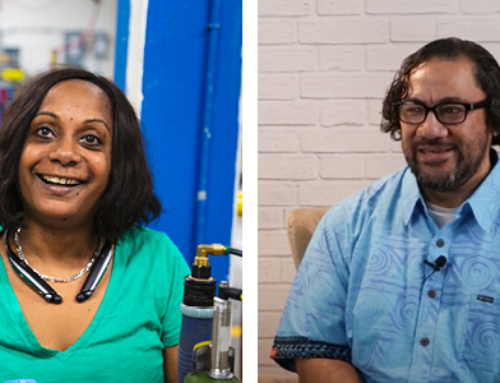By Suzanne Yeagley

Director of Development and Public Relations Greg Szabo and Finn
Almost ten years ago, Greg Szabo met his first guide dog, a black lab named Finn, from an organization called Guide Dogs for the Blind.
Greg first met and worked with Finn at a two-week training in Oregon. Greg says, “At first, it was difficult putting trust in a dog.” On one of their first days together, the sun was shining and Greg was enjoying their walk. He was relaxing and happily walking along with Finn when the instructor yelled, “Stop!”
Greg didn’t hear her and walked right into a bus pole. After the incident, Greg said, “I’ve had more friends walk me into a pole than the dog has.”
After nine years together, in March 2018, it was Finn’s time to retire.
“Usually dogs retire around age eight,” Greg says. “Finn was ten, but he started to slow down his pace a lot. The biggest sign was that he no longer enjoyed riding in busses and cars. He was shaking on the bus one day, so I decided that it would be his last week of working.”
Greg was without a dog for five months, when he got a new dog. It’s another adorable black lab, named Keating who named after one of the veterinarians at Guide Dogs for the Blind.
“When they handed me Keating,” Greg says, “I was like, ‘Did you guys clone my other dog?'”

Finn the Guide Dog
They quickly learned to work together as a team. “I have a complete trust in him already,” Greg says. “I don’t have any fear when I’m out with him. The efficiency of travel when I’m with him is really great.”
Guide Dogs for the Blind, an organization that has approximately 2,200 dogs across the world, picked the right dog for Greg. They measured his stride, how fast he walked, and they watched his mobility–like how he navigated intersections. Then they took the information and plugged it into a computer, and the result was a match with Keating.
Greg is the Director of Public Relations and Development at the Spokane facility of The Lighthouse for the Blind, Inc. His job requires him to travel quite a bit and when he first met Keating, they went to a subway platform, where Keating did what is called “intelligent disobedience.” When Greg told him to walk forward toward the empty train tracks, Keating turned Greg to the right and got between Greg and the tracks.
“It was really cool to see that level of training,” Greg says.
During the two-week training Greg and Keating would learn a route from the guide dog lounge to a Starbucks, an eight-block walk. They’d do that route four to six times the first week. They’d also do other public activities like going to the mall.
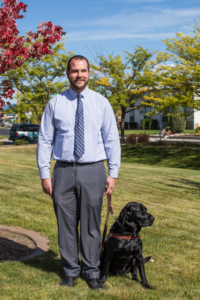
Greg and Keating outside on a sunny day in Spokane
The second week of training was geared more towards Greg’s lifestyle when he would return home. Greg attends Eastern Washington University— so Greg, Keating, and the trainer went to the UC Berkeley campus to get the feel of what it would be like when Greg took Keating back to school.
The guide dogs themselves begin their training when they are puppies. They are taught basic commands like sit and stay, and are acclimated to being with the public. Then the dogs go through a 90-day process where they complete eight levels of training, and not all the dogs make it. Being a guide dog is not an easy career.
It’s not all hard work though.”When they’re not in their harness, they are your typical crazy dog,” Greg says. “When they’re not working, they know it, and they have fun.”
Keating in particular is only a year and a half old and has a ton of energy, even after a long day of work. And Finn is adjusting to having a new dog at home. Even though he’s 11, he doesn’t have a grey hair on him.
Greg loves the dogs and his life with them. “It relieves some anxiety when you have a dog next to you,” he says. “And for me, it’s just a much simpler way of traveling.”

